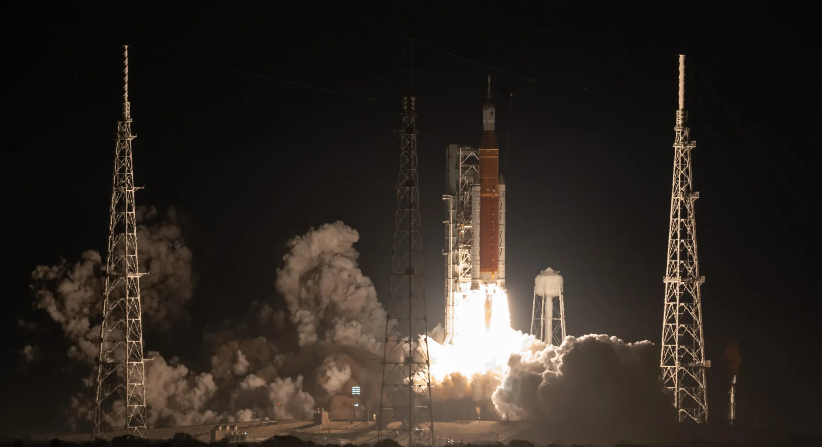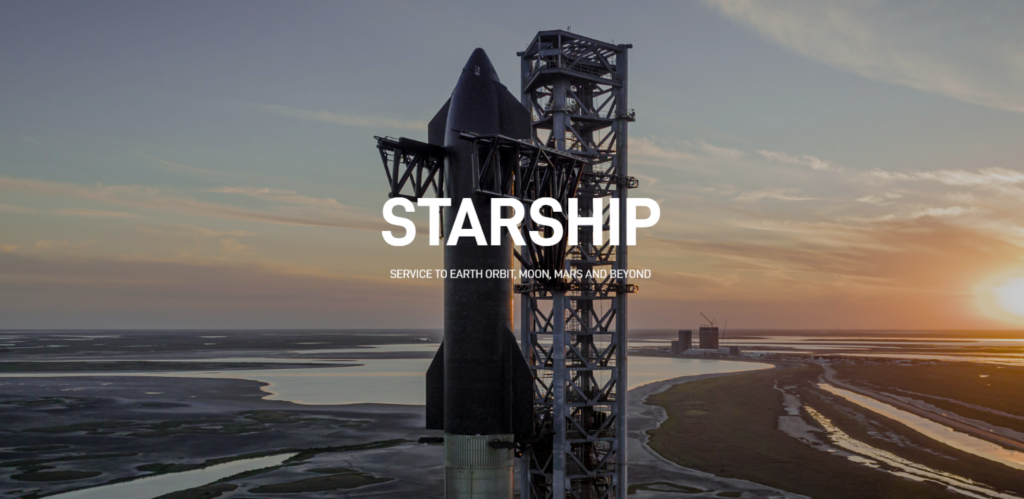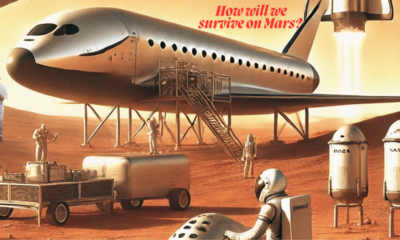Innovations
The Future of Space Exploration: Latest Updates on Missions to Mars and the Moon from NASA and SpaceX

Space exploration has entered a new era marked by unprecedented advancements and ambitions. Both government space agencies, like NASA, and private companies, such as SpaceX, are pushing the boundaries of what is possible in space travel and exploration. The latest developments in missions to Mars and the Moon signal a renewed commitment to exploring the final frontier, driven by both scientific curiosity and the potential for future economic opportunities. This report provides a comprehensive analysis of the most current updates in space exploration, focusing on missions to Mars and the Moon, and examines the broader implications of these endeavors.
NASA’s Artemis Program: A Return to the Moon

NASA Artemis 1
1. Overview of the Artemis Program
NASA’s Artemis program represents the United States’ boldest initiative in lunar exploration since the Apollo missions of the 1960s and 1970s. Named after the twin sister of Apollo in Greek mythology, Artemis aims to return humans to the Moon by 2025, including the first woman and the next man. The program’s ultimate goal is to establish a sustainable human presence on the Moon by the end of the decade, paving the way for future missions to Mars.
2. Artemis I Mission: Testing the Waters
The Artemis I mission, an uncrewed test flight, marked the first integrated flight of NASA’s Space Launch System (SLS) rocket and the Orion spacecraft. Launched on November 16, 2022, Artemis I was designed to test the performance of these systems in deep space and to ensure that they are capable of safely carrying astronauts to and from the Moon. The mission successfully completed a 25-day journey around the Moon, covering a distance of over 1.3 million miles and gathering critical data that will inform future missions.
The successful completion of Artemis I is a significant milestone for NASA, demonstrating the reliability of the new SLS rocket, which is the most powerful rocket NASA has ever built. The mission also tested the heat shield of the Orion spacecraft during re-entry into Earth’s atmosphere, a crucial component for the safety of future crewed missions.
3. Artemis II: The First Crewed Mission
Scheduled for launch in 2024, Artemis II will be the first crewed mission under the Artemis program. It will carry four astronauts on a 10-day mission that will take them around the Moon and back to Earth. This mission will be the first time humans have traveled beyond low Earth orbit since Apollo 17 in 1972. Artemis II aims to test the life support systems and other critical components of the Orion spacecraft in preparation for future lunar landings.
The crew of Artemis II will include astronauts from NASA as well as international partners, highlighting the collaborative nature of modern space exploration. The mission is expected to provide valuable experience in deep space travel and help refine the procedures that will be used in subsequent missions, including the landing of astronauts on the lunar surface.
4. Artemis III: Landing on the Moon
Artemis III, currently planned for 2025, will be the first mission to land astronauts on the Moon since 1972. The mission will target the lunar South Pole, a region that is of particular interest to scientists due to the presence of water ice in permanently shadowed craters. The availability of water on the Moon is a critical resource for sustaining long-term human presence and could potentially be used to produce oxygen and hydrogen for life support and fuel.
The lunar lander for Artemis III will be provided by SpaceX, under NASA’s Human Landing System (HLS) contract. SpaceX’s Starship, which is currently under development, will serve as the lander, transporting astronauts from lunar orbit to the surface and back. This collaboration between NASA and SpaceX marks a significant shift in how space exploration is conducted, with private companies playing an increasingly central role in human spaceflight.
5. The Gateway: A Lunar Outpost
A key component of the Artemis program is the Lunar Gateway, a space station that will orbit the Moon and serve as a staging point for missions to the lunar surface and beyond. The Gateway will support long-term lunar exploration and provide a platform for scientific research, crewed missions, and international partnerships. It will also play a critical role in preparing for future missions to Mars, acting as a testbed for deep space habitation and operations.
The first elements of the Gateway, including the Power and Propulsion Element (PPE) and the Habitation and Logistics Outpost (HALO), are scheduled to be launched in the mid-2020s. These components will be delivered by commercial partners, further demonstrating the collaborative nature of the Artemis program.
SpaceX: Leading the Charge to Mars

SpaceX Starship
1. SpaceX’s Vision for Mars
SpaceX, founded by Elon Musk in 2002, has become a driving force in the new space race, with its sights set firmly on Mars. Musk has articulated an ambitious vision to establish a self-sustaining colony on Mars, with the long-term goal of making humanity a multi-planetary species. SpaceX’s efforts to achieve this vision are centered around the development of the Starship spacecraft, a fully reusable launch and landing system designed to carry both crew and cargo to the Moon, Mars, and beyond.
2. Starship Development: A Revolutionary Spacecraft
The Starship spacecraft is the cornerstone of SpaceX’s Mars ambitions. Designed to be fully reusable, Starship consists of two stages: the Super Heavy booster and the Starship spacecraft itself. The Super Heavy booster provides the initial thrust needed to escape Earth’s gravity, while Starship is capable of carrying up to 100 passengers and a large amount of cargo to destinations in space.
As of 2024, SpaceX has conducted multiple high-altitude test flights of Starship prototypes, with varying degrees of success. The most significant milestone was the first orbital test flight, which took place on April 20, 2023. Although the test ended with the spacecraft being intentionally destroyed after several issues were encountered, it provided valuable data that SpaceX is using to refine the design and improve the reliability of future flights.
The ultimate goal for Starship is to conduct the first crewed mission to Mars in the late 2020s. SpaceX is also working on the development of life support systems, in-situ resource utilization (ISRU) technologies, and other critical systems needed to sustain human life on Mars. Musk has indicated that the first mission could involve a small crew and focus on establishing the initial infrastructure needed for future expansion.
3. Mars Base Alpha: The First Martian Settlement
SpaceX’s long-term plan involves the creation of Mars Base Alpha, the first human settlement on the Red Planet. This base will serve as the hub for future colonization efforts and will be designed to support a growing population of settlers. The base will be equipped with habitats, research facilities, and the infrastructure needed to produce food, water, and energy on Mars.
One of the key challenges for Mars Base Alpha is the harsh environment of Mars, including its thin atmosphere, extreme temperatures, and high levels of radiation. SpaceX is exploring a variety of solutions to these challenges, including the use of underground habitats, advanced radiation shielding, and the production of resources from local materials.
The establishment of a permanent human presence on Mars would be a historic achievement, marking the beginning of a new chapter in space exploration. However, the challenges are immense, and the success of these efforts will depend on a combination of technological innovation, international collaboration, and sustained investment.
4. Collaboration with NASA and Other Partners
While SpaceX is pursuing its own Mars ambitions, the company is also collaborating closely with NASA and other international partners. SpaceX’s Starship has been selected by NASA as the lunar lander for the Artemis III mission, and the company continues to provide crewed and cargo flights to the International Space Station (ISS) under NASA’s Commercial Crew Program.
In addition to its work with NASA, SpaceX is exploring partnerships with other space agencies, research institutions, and private companies. These collaborations are critical to advancing the technologies needed for Mars exploration and ensuring that the benefits of space exploration are shared globally.
The Broader Implications of Space Exploration
1. Scientific Discovery and Innovation
The exploration of the Moon and Mars holds immense potential for scientific discovery. The Moon, with its relatively unaltered surface, provides a unique record of the early solar system, while Mars offers insights into the possibility of life beyond Earth. The data gathered from these missions will not only advance our understanding of the universe but also drive innovation in a wide range of fields, from materials science to medicine.
For example, the discovery of water ice on the Moon and Mars has significant implications for our understanding of the history of these bodies and the potential for life. It also presents opportunities for in-situ resource utilization, which could enable future missions to be more self-sufficient and reduce the need for resupply from Earth.
2. Economic Opportunities
The commercialization of space is opening up new economic opportunities, from space tourism to asteroid mining. Companies like SpaceX, Blue Origin, and others are at the forefront of developing the technologies needed to access and utilize space resources. The growing interest in space exploration is also driving investment in related industries, such as satellite communications, space habitats, and planetary protection.
According to a report by Morgan Stanley, the global space industry could generate revenue of over $1 trillion by 2040, driven by increasing demand for satellite services, space exploration, and space-based manufacturing. The potential for economic growth in space is vast, but it will require significant investment and the development of new regulatory frameworks to manage these activities responsibly.
3. International Collaboration and Competition
Space exploration has always been a field where international collaboration and competition coexist. The Artemis program, for example, involves partnerships with space agencies from around the world, including the European Space Agency (ESA), the Japan Aerospace Exploration Agency (JAXA), and the Canadian Space Agency (CSA). These collaborations are essential for pooling resources, sharing expertise, and ensuring that the benefits of space exploration are distributed globally.
At the same time, there is increasing competition in space, particularly between the United States, China, and Russia. China’s ambitious space program, which includes plans for a lunar base and missions to Mars, is seen as a strategic challenge by the United States. This competition could drive innovation but also raises concerns about the potential for conflict in space.
4. Ethical and Environmental Considerations
The exploration of the Moon and Mars raises a number of ethical and environmental considerations. The potential for human settlement on other planets brings with it questions about the preservation of these environments and the protection of any potential extraterrestrial life. There are also concerns about the impact of space exploration on Earth’s environment, particularly in terms of space debris and the carbon footprint of rocket launches.
NASA and other space agencies are developing guidelines and best practices for planetary protection and sustainable space exploration. These efforts aim to balance the need for exploration with the responsibility to protect the environments we explore.
Conclusion
Space exploration is entering a new era, characterized by ambitious missions to the Moon and Mars and the increasing involvement of private companies like SpaceX. These efforts hold the promise of scientific discovery, economic growth, and the expansion of human presence beyond Earth. However, they also present significant challenges, from technological and financial hurdles to ethical and environmental concerns.
The success of these missions will depend on a combination of innovation, collaboration, and responsible stewardship of space. As humanity takes its next steps into the cosmos, the decisions we make today will shape the future of space exploration for generations to come. Whether it is the return to the Moon with NASA’s Artemis program or the push to Mars led by SpaceX, the next decade promises to be one of the most exciting and transformative periods in the history of space exploration.
-

 Press Release5 days ago
Press Release5 days agoNura Labs Files Revolutionary Patent: AI-Powered Wallet Solves the $180 Billion Crypto Staking Complexity Crisis
-

 Press Release3 days ago
Press Release3 days agoGlobal Compound Feeds and Additives Industry Report: Market Expansion and Competitive Insights to 2035
-

 Technology3 days ago
Technology3 days agoWhat to Know Before Switching Cell Phone Network Services in 2025
-

 Press Release2 days ago
Press Release2 days agoCrypto WINNAZ Launches First On-Chain Yield Engine for Meme Coins, Enabling 20x–300x Returns





















